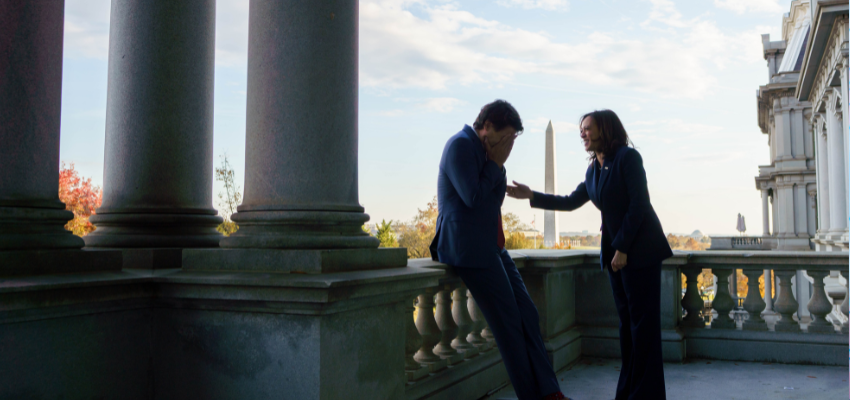This article originally appeared in Real Clear World.
By Jerome Gessaroli, September 20, 2024
Kamala Harris’s presidential campaign is following a political playbook that has already reshaped a nation – not the United States, but Canada under Justin Trudeau. As someone who has followed politics for decades on both sides of the 49th parallel, I feel a powerful sense of déjà vu watching Kamala Harris’s presidential campaign develop. There are remarkable similarities between Harris’s and Justin Trudeau’s rhetoric during his first successful campaign for prime minister in 2015. It is obvious that the two work in quite different political environments. Still, their ideals and campaign strategies share some remarkable parallels that could offer a glimpse into America’s future under a Harris presidency.
Voters see Harris, and saw Trudeau, as fresh faces in their respective runs for office – largely free from the burden of past policies. They have positioned themselves as progressive candidates but with a keen eye on communicating to the middle class a moderate policy direction. Trudeau’s “sunny ways” and Harris’s “politics of joy” both seek to bring optimism into the political discourse, appealing to younger voters.
Their progressive agendas overlap significantly. Trudeau campaigned over inclusive policies, feminism, and a gender-balanced government. Harris is a loud voice for women’s equality, voting rights, and ending systemic racism. There are, however, further similarities. Just as Trudeau made middle-class tax cuts and enhanced childcare a campaign priority, Harris, too, is making middle-class tax cuts and better childcare policies the center of her economic promises.
The media portrayals of both candidates are very similar. The media depicted Trudeau as charismatic and a symbol of inclusive Canadian values, while they portray Harris as a trailblazer and a symbol of progress in American politics. Both have faced criticisms about their readiness to lead. Yet, their personal stories—Trudeau as a former teacher and Harris as the first Black Vice President and Black female Attorney General of California – have been used to connect with voters.
Trudeau ran on a platform of policies breaking from his conservative predecessor, while Harris promises to bring a new viewpoint while maintaining many of President Joe Biden’s programs. The political landscapes of Canada and the United States also differ, particularly regarding federal-state dynamics and the extent of executive power.
So, what might a Harris presidency look like based on the Trudeau experience?
If the parallels hold, we can see a stronger emphasis on diversity in appointments, giving representation precedence over traditional qualifications – as well as greater attention to civil rights and minority issues, out of proportion to their importance in broader policy overall.
Tensions between the federal and state governments will rise, especially around energy policy and regulatory mandates. For example, in pursuit of implementing its preferred environmental policies, Trudeau’s Liberal government enacted the Impact Assessment Act, which expanded federal oversight of environmental reviews for major natural resource projects.
Over and above its lack of constitutionality, the Act also required that projects evaluate their impact on “systemic racism,” “colonialism,” and “2SLGBTQQIA individuals.” You may also see this appearing where least expected. For instance, the Prime Minister’s Office announced millions of dollars to support demining efforts in Ukraine through “gender-responsive mine action operations.”
Politicians with progressive values favor using broader powers to regulate speech to protect marginalized groups from hate speech and other “online harms.” Trudeau’s proposed Online Harms Act allows anyone who finds specific speech or writing offensive to file a human rights complaint, a measure that was met with considerable pushback. The original version of the Act even included provisions that aimed to address “misinformation,” however that term may be defined. Such laws may align with a Harris administration’s desire to oversee digital spaces. Anticipate increased tension with individual states and more legal challenges regarding divisive and intrusive legislation.
One particularly interesting parallel is their approach to contentious social issues. Trudeau has repeatedly used abortion as a wedge issue to bolster his support. Harris, too, emphasized her defense of abortion rights during the presidential debate but notably avoided addressing whether she supports a ban on late-term abortions, downplaying more strident positions in order not to alienate middle-class voters.
As we watch Harris’s campaign unfold, it is worth considering these parallels. While the United States and Canada are distinct nations with their own political realities, the similarities between Harris and Trudeau suggest American voters may be in for a familiar political journey – one characterized by promises based on moderate middle-class values but having to deal with progressive ideals that do not represent the middle class.
In the end, as Harris herself said, “America, we are not going back. We are charting. A. New. Way. Forward.” Whether that way forward resembles Canada’s recent path remains to be seen.
Jerome Gessaroli is a senior fellow at the Macdonald-Laurier Institute and the Center for North American Prosperity and Security. He leads the Sound Economic Policy Project at the British Columbia Institute of Technology.








